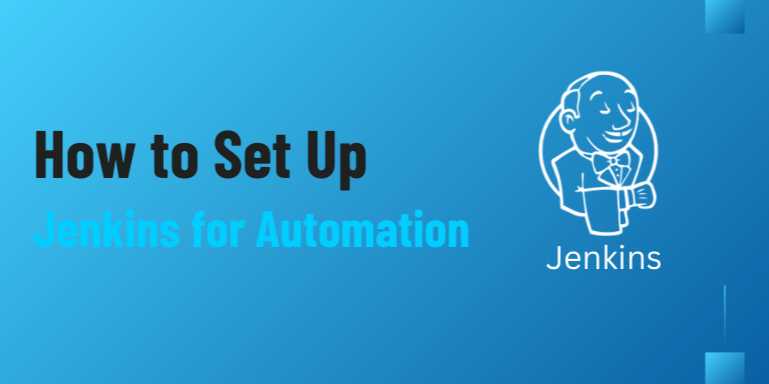How to Set Up Jenkins for Automation: A Complete Beginner’s Guide to CI/CD

📘 Chapter 4: Writing and Managing Jenkins Pipelines
🔐 Introduction
While Freestyle jobs are great for getting started, modern
DevOps workflows require more flexibility, maintainability, and scalability.
That’s where Jenkins Pipelines come in.
Pipelines allow you to define the entire build, test, and
deploy workflow as code, making your automation version-controlled,
reproducible, and easier to maintain. Whether you’re deploying a simple app or
orchestrating a complex microservice architecture, pipelines put you in full
control.
In this chapter, we’ll explore the power of Jenkins
Pipelines — how to write them, manage them, and optimize them for
real-world CI/CD automation.
🤔 What is a Jenkins
Pipeline?
A Jenkins Pipeline is a suite of plugins that support integration
and implementation of continuous delivery pipelines using code. Pipelines
are written using a domain-specific language (DSL) based on Groovy.
You can define them in:
- The
Jenkins UI (inline definition)
- A Jenkinsfile
stored in your project’s repository (best practice)
🔧 Benefits of Using
Jenkins Pipelines
|
Benefit |
Explanation |
|
Pipeline-as-Code |
Workflows are
version-controlled with the source code |
|
Scalability |
Handle large,
multi-stage workflows easily |
|
Maintainability |
Easier to debug,
modify, and reuse |
|
Reusability |
Share steps
across multiple projects |
|
Portability |
Works consistently
across environments |
|
Integration Flexibility |
Integrates
with Docker, Kubernetes, Slack, AWS, etc. |
🔁 Declarative vs Scripted
Pipelines
|
Aspect |
Declarative
Pipeline |
Scripted Pipeline |
|
Syntax |
Simplified, YAML-like |
Full Groovy scripting |
|
Readability |
High |
Medium (more
complex) |
|
Flexibility |
Medium |
High (more control
over logic) |
|
Use Case |
Most common workflows |
Complex logic
and loops |
|
Recommended For |
Beginners and teams |
Advanced users and
special cases |
🧾 Declarative Pipeline
Example
groovy
pipeline
{
agent any
stages {
stage('Build') {
steps {
echo 'Building...'
sh 'npm install'
}
}
stage('Test') {
steps {
echo 'Running tests...'
sh 'npm test'
}
}
stage('Deploy') {
steps {
echo 'Deploying...'
}
}
}
}
🔍 Scripted Pipeline
Example
groovy
node
{
stage('Build') {
echo 'Building...'
sh 'npm install'
}
stage('Test') {
echo 'Running tests...'
sh 'npm test'
}
stage('Deploy') {
echo 'Deploying...'
}
}
🧱 Anatomy of a
Jenkinsfile
|
Section |
Purpose |
|
pipeline block |
Starts the declarative
syntax |
|
agent |
Where to run
the pipeline (e.g., any, docker, label) |
|
stages |
Logical grouping of
build steps (Build, Test, Deploy) |
|
steps |
Commands/scripts
to execute |
|
environment |
Define environment
variables |
|
post |
Actions to
run after job completes (success/failure) |
🔁 Real-World Example:
Java App CI/CD Pipeline
groovy
pipeline
{
agent any
environment {
MVN_HOME = '/usr/share/maven'
}
stages {
stage('Checkout') {
steps {
git
'https://github.com/example/repo.git'
}
}
stage('Build') {
steps {
sh "${MVN_HOME}/bin/mvn clean
install"
}
}
stage('Test') {
steps {
sh "${MVN_HOME}/bin/mvn test"
}
}
stage('Deploy') {
steps {
sh './scripts/deploy.sh'
}
}
}
post {
success {
echo 'Pipeline completed successfully!'
}
failure {
echo 'Pipeline failed!'
}
}
}
🧰 Useful Pipeline
Directives
|
Directive |
Function |
|
agent |
Defines where to run
the stage or pipeline |
|
tools |
Install build
tools like Maven, JDK |
|
input |
Pause pipeline for manual
approval |
|
timeout |
Fails the
stage if it takes too long |
|
retry |
Retries the stage on
failure |
|
when |
Adds
conditional logic to stage execution |
⚙️ Pipeline Visualization Tools
|
Plugin |
Purpose |
|
Blue Ocean |
Graphical UI for
pipeline visualization and management |
|
Pipeline Stage View |
Shows
execution details and duration by stage |
|
Build Timeline
Plugin |
Displays build history
as a timeline |
🧪 Best Practices for
Managing Pipelines
- Always
use a Jenkinsfile in source control
- Use descriptive
stage names
- Separate
environment-specific config (via parameters or folders)
- Use parallel
stages for faster builds
- Secure
credentials via Jenkins credentials manager
- Monitor
build performance via timestamps and metrics
📘 Advanced Pipeline
Features
|
Feature |
Description |
|
Parallel Execution |
Run multiple stages
simultaneously (e.g., parallel tests) |
|
Shared Libraries |
Define
reusable functions and steps across pipelines |
|
Matrix Builds |
Test across OS or
language versions |
|
Artifact Archiving |
Save build
results for download or later use |
|
Slack Notifications |
Send pipeline updates
to your team’s Slack channels |
📈 Pipeline Metrics That
Matter
|
Metric |
Why It’s Useful |
|
Build Duration |
Optimize slow stages |
|
Stage Success Rate |
Identify
flaky or failing stages |
|
Failure Cause |
Fix issues early with
logs and error context |
|
Deployment Frequency |
Track how
often software is delivered |
|
Lead Time for
Changes |
Time from code commit
to deploy |
📘 Summary
Jenkins Pipelines are the backbone of modern CI/CD
workflows. They let you codify your automation logic, control execution
precisely, and collaborate more effectively as a team. As you progress, you can
move from simple pipelines to complex workflows involving containers,
microservices, cloud deployments, and more.
A Jenkins job gets things done — a Jenkins Pipeline gets
everything done, reliably and repeatedly.
FAQs
1. What is Jenkins and why is it used in automation?
Jenkins is an open-source automation server that helps developers automate building, testing, and deploying code. It enables Continuous Integration and Continuous Delivery (CI/CD), making software delivery faster and more reliable.
2. What are the system requirements to install Jenkins?
To install Jenkins, you need:
- Java
11 or later (Java 17 recommended)
- At
least 2 GB of RAM and 1 GB of disk space
- A
modern browser for accessing the Jenkins UI
3. What’s the easiest way to install Jenkins for beginners?
The simplest way is to use the Jenkins WAR file:
java -jar jenkins.war
Alternatively, you can use a Docker container for a quick and clean setup:
docker
run -p 8080:8080 jenkins/jenkins:lts
4. How do I connect Jenkins to my GitHub repository?
Install the Git and GitHub plugins, then:
- Create
a new job or pipeline
- Choose
“Git” as the source code management
- Enter
the GitHub repo URL and credentials if needed
- Add
a webhook to trigger Jenkins builds on each push
5. What is a Jenkins Pipeline?
A pipeline is a script-based workflow written in Groovy DSL that defines your automation steps (e.g., build, test, deploy). Pipelines can be declarative (simplified) or scripted (flexible).
6. What plugins should I install first in Jenkins?
For basic automation, start with:
- Git
plugin (source control)
- Pipeline
plugin (workflow scripting)
- Docker
plugin (if using containers)
- Blue
Ocean (modern UI for pipelines)
- Email
Extension (build notifications)
7. Can Jenkins be used with Docker and Kubernetes?
Yes! Jenkins integrates with Docker for building images and with Kubernetes for scaling jobs using agents. Tools like Jenkins X also help automate deployments in Kubernetes.
8. How do I secure my Jenkins installation?
- Use
HTTPS for the web UI
- Create
individual user accounts
- Configure
role-based access controls
- Mask
secrets and tokens in logs
- Regularly
update plugins and Jenkins core
9. How do I trigger Jenkins builds automatically?
You can:
- Use webhooks
from GitHub/GitLab
- Schedule
jobs using CRON syntax
- Trigger
builds after another job completes
- Use
a poll SCM trigger to check for changes periodically
10. Is Jenkins free to use for commercial projects?
Yes! Jenkins is 100% free and open-source, licensed under MIT. You can use it in personal, educational, and commercial environments without restriction.
Tutorials are for educational purposes only, with no guarantees of comprehensiveness or error-free content; TuteeHUB disclaims liability for outcomes from reliance on the materials, recommending verification with official sources for critical applications.
Explore Other Libraries
Please allow ads on our site
Kindly log in to use this feature. We’ll take you to the login page automatically.
Login
Join Our Community Today
Ready to take your education and career to the next level? Register today and join our growing community of learners and professionals.

Your experience on this site will be improved by allowing cookies. Read Cookie Policy
Your experience on this site will be improved by allowing cookies. Read Cookie Policy

Comments(0)